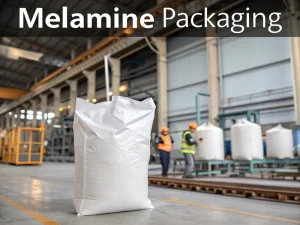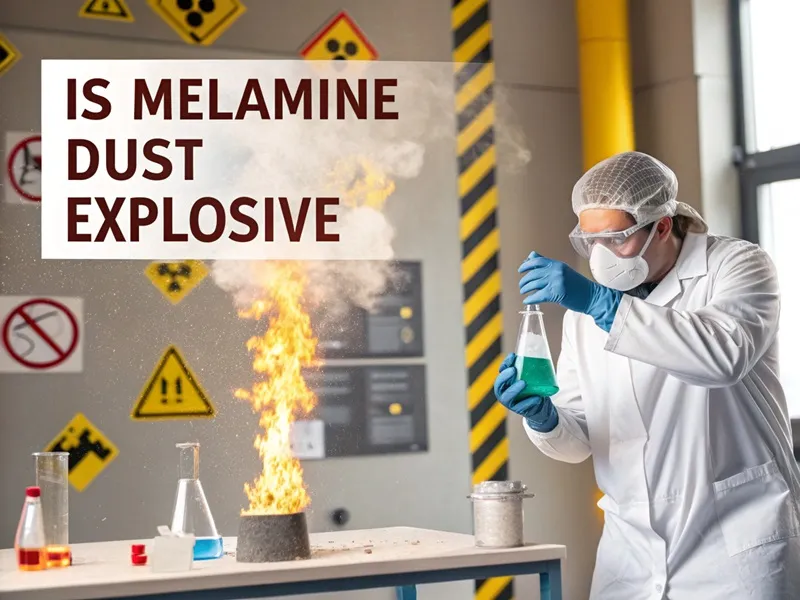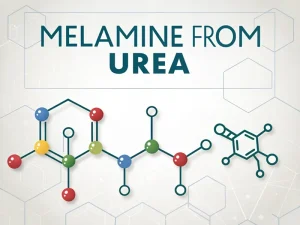
Melamine Packaging
Tech Blog Melamine packaging For manufacturers, inaccurate packaging not only fails to meet national standards but also increases labor costs and the risk of product

Melamine powder is a compound widely used in various industries, including resins, plastics, coatings, and adhesives. Because melamine dust is usually processed in powder form, the issue of whether melamine dust is explosive has become crucial, especially in industrial environments where safety is paramount.
This article will explore the properties of melamine dust and the factors affecting dust explosiveness and provide a comprehensive answer to this question.

The chemical formula of melamine is C3H6N6. It is composed of a heterocyclic aromatic structure with three nitrogen-containing rings. This chemical structure endows melamine with unique properties, such as high-temperature resistance and chemical stability under normal conditions. It is also an important raw material for synthesizing melamine formaldehyde resin, which is widely used in various products due to its excellent mechanical and thermal properties.
Melamine is a white, odorless crystalline powder with a density of about 1.574 grams per cubic centimeter. When in powder form, it is easily dispersed in the air. This powder form is common in manufacturing factories, and melamine is used as a raw material for various products.
Four main conditions must be met to trigger a dust explosion: combustible dust, oxidizer (usually oxygen in the air), ignition source, and confined space (although the explosion may also occur in an unrestricted but dust-rich environment with sufficient concentration).
Combustible dust: It is considered combustible if it can burn in a fine state. Especially organic dust, which is usually flammable. The small particle size and large surface area to volume dust ratio mean more dust is exposed to oxygen. When ignited, this large surface area can cause rapid combustion reactions.
Oxidant: Oxygen in the air is the most common oxidant. Under normal atmospheric conditions, the air contains about 21% oxygen, which can support the combustion of combustible dust.
Ignition source: Sparks, flames, hot surfaces, or electrostatic discharge. If other conditions are met, even small amounts of energy from these sources can trigger the combustion of dust particles.
Sealed space: In a sealed space, the pressure generated by the rapid combustion of dust is not easily dissipated. When dust burns, it releases a large amount of heat and gas, causing rapid pressure accumulation and ultimately leading to an explosion. In an unrestricted space, if the dust concentration is high enough, large-scale fires may still occur, which is equally dangerous.
Melamine dust is flammable. Although melamine has a certain degree of chemical stability, when dispersed in fine powder form in the air, it can react with oxygen in the presence of an ignition source.
The nitrogen-rich structure of melamine can participate in combustion reactions. When melamine dust burns, it releases heat and forms combustion products such as carbon dioxide, water vapor, and nitrogen oxides.
The ignition sensitivity of melamine dust depends on several factors. Particle size is a key factor. Smaller particles are easier to ignite because their surface area-to-volume ratio is larger. Smaller particle size allows for more efficient heat transfer and faster reaction with oxygen.
In addition, the concentration of melamine dust in the air is also important. Melamine dust in the air has a minimum concentration (lower explosive limit, LEL) and a maximum concentration (upper explosive limit, UEL). Suppose the dust concentration is lower than LEL. In that case, there is insufficient fuel to support combustion, and if the dust concentration is higher than UEL, there is insufficient oxygen.
For melamine dust, the exact LEL and UEL values may vary depending on experimental conditions, but generally, concentrations of tens to hundreds of grams per cubic meter may be within the explosive range.
In industrial facilities that handle melamine powder, such as melamine resin manufacturing plants, there have been incidents of melamine dust explosions. If appropriate safety measures are not taken, simple sparks generated by machinery, electrostatic discharge, or lit cigarettes can ignite melamine dust in the air.
These explosions can cause significant damage to facilities, including equipment destruction and structural damage, and pose a serious threat to the safety of workers. In addition to the immediate explosion, the combustion of melamine dust can also release harmful gases, which can cause health problems if inhaled.
Dust removal system: It is crucial to install an efficient dust removal system. These systems can capture melamine dust particles before they disperse into the air and reach explosive concentrations. Filters with a high-efficiency particulate air (HEPA) rating can capture small melamine dust particles.
Ventilation: Proper ventilation is crucial for diluting the concentration of melamine dust in the air. A well-designed ventilation system can continuously exhaust dusty air from the work area and replace it with fresh air to keep the dust concentration below the explosive limit.
Antistatic: Melamine powder can accumulate static electricity during handling, transportation, and processing. To prevent electrostatic discharge, the equipment should be properly grounded, and antistatic materials should be used during transportation. Workers should also wear antistatic clothing and shoes.
Smoking ban and fire source control: Strict smoking bans should be implemented in areas with melamine dust. All potential ignition sources, such as open flames, mechanical sparks, and electrical equipment that may generate sparks should be eliminated or appropriately protected.
Worker training: Workers should receive training on the hazards of melamine dust, including its explosiveness. They should be taught how to safely operate equipment, identify and report potential ignition sources, and respond in emergency situations related to dust.
Emergency plan: Enterprises should develop clear emergency plans. These plans should include procedures for evacuating facilities, extinguishing fires, and handling harmful gas releases in the event of a melamine dust explosion.

Tech Blog Melamine packaging For manufacturers, inaccurate packaging not only fails to meet national standards but also increases labor costs and the risk of product

Tech Blog How to Detect Melamine in Textiles? Melamine powder, a nitrogen-containing heterocyclic compound, is widely used in flame-retardant textiles and plastic products due to

Tech Blog melamine from urea Melamine is well-known for its wide range of applications, but its raw material for production is surprisingly urea. For manufacturers,

JINGJIANG MELAMINE POWDER
© JINJIANG MELAMINE